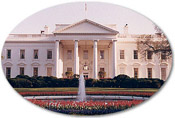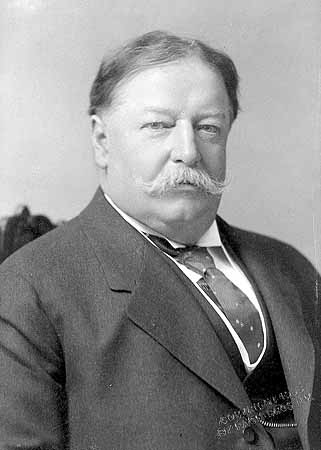

WILLIAM HOWARD TAFT
Biography

When William Howard Taft became President of the United States in 1909, great things were expected of him. The previous president, Theodore Roosevelt, one of the most popular in American history, had supported him enthusiastically, and Taft had promised to carry on Roosevelt's policies. Taft had already served the country for many years in a variety of important positions. In the 1908 election the people had chosen him over the Democratic candidate, William Jennings Bryan, by more than 1,000,000 popular votes. Yet Taft's administration was a disappointment to his supporters. He failed to win reelection in 1912 but later went on to a distinguished career as chief justice of the United States.
His Public-Service Career
Taft became interested in Republican politics in Ohio, and in 1881 he was appointed assistant prosecutor in Hamilton County. In 1887 he was named a judge on the Ohio superior court. In 1890, President Benjamin Harrison offered him the post of solicitor general of the United States, the second-ranking office in the Department of Justice. Taft accepted, but in 1892 he resigned this important office to become a federal circuit court judge.
Taft would have happily spent his entire life in this post. In 1899 he even turned down an offer of the presidency of Yale College. However, in 1900 he accepted President William Mckinley's request that he become head of a special commission to oversee the government of the Philippine Islands. The Philippines had been acquired by the United States from Spain in 1898 after the Spanish-American War. In the Philippines, Taft demonstrated his ability as an administrator, and in 1901 he was appointed by McKinley as the first civilian governor of the islands.
Taft proved to be an excellent colonial governor. The Filipinos, objecting as much to American rule as to Spanish, were in rebellion against American troops when Taft arrived. Although he insisted that they lay down their arms, he developed a great affection for the people of the Philippines and carried out many important reforms. He saw to it that landless peasants were permitted to buy land at fair prices. He improved the school system, built many roads, and did everything possible to prepare the people for eventual independence. So interested was he in this work that he twice refused appointment to the United States Supreme Court—his highest ambition—because he felt that his work in the islands had not been completed.
However, in 1904 his friend Theodore Roosevelt, then president, appointed him secretary of war. This post enabled Taft to continue to supervise the Philippines. Heading the War Department also put him in charge of the building of the Panama Canal. He became one of Roosevelt's most trusted advisers, and soon he was being mentioned as a leading candidate for the office of president himself.
A Reluctant President
Taft did not want to be president. But his family,especially his wife, Helen Herron Taft, whom he had married in 1886, urged him to accept the nomination. When Roosevelt formally asked him to run, he reluctantly agreed.
This was a mistake. The hectic pressures of the White House made him an unhappy man. On the one hand, he spent too much time on the golf course. On the other, he complained that his work forced him to rush his meals and forego his afternoon nap. He hated to make speeches, and when he did, he was usually dull and long-winded. Too often he left important decisions to others. One critic called him “an amiable island completely surrounded by men who know exactly what they want.” Taft had been an excellent administrator when working under someone else's direction. But he was not successful when faced with the final responsibility for establishing policy and directing the entire national government.
The Tariff
Taft's first move as president was to urge Congress to lower the tariff duties on foreign goods coming into the United States. Originally, high tariffs had seemed necessary to protect new American industries against European competition. But by 1900 American manufacturers were the most efficient in the world. High tariffs simply raised the cost of living for consumers and gave the manufacturers extra profits.
During the 1908 election campaign the Republican Party had promised to revise the tariff. This, everyone assumed, would mean lowering it. The new Payne-Aldrich tariff bill, however, made only very small changes in the law, and many reformers expected Taft to veto it. Taft was disappointed with the measure, but thought it at least better than the existing tariff. Therefore he signed it into law. Perhaps this was sensible. But Taft angered many citizens by actually praising the Payne-Aldrich Act, even calling it “the best tariff bill the Republican Party ever passed.”
The Pinchot Controversy
Next Taft angered the liberals by seeming to reverse Roosevelt's conservation policies. Roosevelt was a great nature lover. He had been disturbed by the rapid destruction of the nation's forest and mineral resources by lumber and mining companies and had established many large national parks and reserves in the West. His chief forester, Gifford Pinchot (1865-1945), was a leading conservation expert. Taft also believed in conservation, and he kept Pinchot on as chief forester. But his secretary of the interior, Richard A. Ballinger (1858-1922), who was Pinchot's superior, soon got into an argument with the chief forester over a large tract of public land in Alaska. When Pinchot accused Ballinger of allowing this land to be gobbled up by a big coal-mining company, Taft ordered an investigation. The inquiry convinced Taft that Ballinger had done no wrong, so he ordered Pinchot to stop his attacks. Pinchot refused, and Taft then removed him from office. While he was probably justified in doing so, his action cost him much support among liberal Republicans.
Reforms
Taft did accomplish a number of major reforms. He was responsible for the creation of the Postal Savings System, which provided small depositors with a safe place for their savings. He strengthened the control of the Interstate Commerce Commission over the nation's railroads. He also continued and even expanded Roosevelt's “trust-busting” (antitrust) activities, which involved breaking up some of the large industrial monopolies that had grown up in recent years. But he came to rely increasingly on the conservative wing of the Republican Party and to criticize the reform, or progressive, wing. He believed the progressives were trying to ruin his administration and became so angry that he refused to invite them to White House dinners, receptions, and other social functions.
The Feud with Roosevelt
The reformers turned to Roosevelt for help. After his term had ended, the former president had gone off to Africa to hunt big game and collect specimens for a museum. In 1910 he returned to find himself in the middle of a bitter political fight. Roosevelt genuinely liked Taft and tried to avoid opposing him. Yet all Roosevelt's progressive friends were insisting that Taft had sold out to the reactionaries. For a time Roosevelt tried to remain neutral. But this only angered Taft, who expected Roosevelt to back him up. Gradually they ceased to be friends. Mrs. Taft resented the fact that most people paid more attention to Roosevelt than to her husband. She made things worse by treating Roosevelt's wife and other members of his family coldly. Finally, in 1912, Roosevelt decided to oppose Taft for the Republican presidential nomination.
Taft would actually have been happy to retire from the race. But he felt that he could not honorably step down under the circumstances. He remarked angrily that even a rat will fight when cornered. In the campaign for the nomination Roosevelt won the votes of most of the delegates from states where presidential primaries were held. However, a majority of the convention delegates were not chosen by the voters but by local politicians. Taft won most of their votes because of his power as head of the party. At the convention Taft was nominated on the first ballot.
Roosevelt felt that he had been cheated of the nomination. He therefore decided to form a new party and run for the presidency on his own. This Progressive, or Bull Moose, Party split the Republican vote, and the Democratic candidate, Woodrow Wilson, won the election. Taft ran a poor third, capturing only eight Electoral votes.
Law Professor and Chief Justice
When his term ended in 1913, Taft became a professor of constitutional law at Yale. During World War I he served as joint chairman of the National War Labor Board. After the war he was a leading Republican supporter of Woodrow Wilson's League of Nations. The failure of the Senate to accept American membership in the league greatly distressed him.
Then, in 1921, President Warren Harding named Taft chief justice of the United States. This was the post he had always wanted, and the last 10 years of his life were probably the happiest. As a judge he was conservative. He opposed government control of business and objected particularly to laws giving special treatment to labor unions.
On the other hand, Taft succeeded in simplifying and making more efficient the procedures of the federal courts. Once again it was his skill as a manager, as distinct from ability to lead people, that came to the fore. He also persuaded Congress to construct the magnificent building that today houses the Supreme Court in Washington. Taft's administrative work while on the Supreme Court was probably his most important contribution in a lifetime devoted to public service.
Early in 1930 failing health forced Taft to retire. On March 8, 1930, he died in Washington, D.C., at the age of 72. He was buried in Arlington National Cemetery.
Taft was survived by his wife, two sons, and a daughter. His elder son, Robert Alphonso Taft (1889-1953), became a U.S. senator from Ohio and a leader of the Republican Party. His younger son, Charles Phelps Taft (1897-1983), was mayor of Cincinnati.
John A. Garraty
Columbia University







